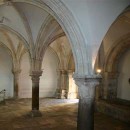The Upper Room – Dispute Between Vatican And Israel

Is there a breakthrough in negotiations between the Vatican and the State of Israel? A timely explosion is taking place on Israeli media on the issue of "transferring" the Last Supper.
The popular Israeli newspaper Yediot Ahronot had an article on a recent meeting of the Bilateral Permanent Working Commission between the State of Israel and the Holy See held in Jerusalem – a meeting at which substantial progress was made in negotiations regarding outstanding issues.
The article went on to say that negotiations were underway to reassign to the Vatican the control of the location where, according to tradition, the Last Supper was held between Jesus and the twelve apostles.
The crux of the matter is that - as so often happens in Jerusalem - at the Last Supper the holy places of both religions intertwine. Located just outside the walls of Suleiman, a few hundred yards from the Zion Gate, the “upper room” where the Gospels place the Last Supper (but also Pentecost) is in fact above another room where Jews revere the tomb of King David.
For this reason, the room of the Last Supper is now just a museum, visited by Christian pilgrims but without being able to celebrate any rite. With the paradox that a mass cannot be celebrated in the very spot where Jesus instituted the Eucharist. The only exception occurred in March 2000, during the journey to the Holy Land of John Paul II: Wojtyla was allowed to preside at a Eucharistic liturgy here, something that had not occurred during the journey of Paul VI in 1964 and was never repeated even for that of Benedict XVI in 2009.
To really understand the plot, however, it is necessary to go through the whole history of this place. Because the point is that the presence of a Judeo-Christian community in this corner of Jerusalem is ancient. According to archaeologists “the synagogue of the Christians” on Mount Zion was one of the few spared by the Emperor Hadrian in the second century AD when, after the second Jewish revolt, he destroyed Jerusalem.
It is certain that a Byzantine basilica was already here in the fourth century. However, the discovery of the cenotaph which was then indicated as the Tomb of David only dates back to the crusades. In 1167 Rabbi Avraham of Jerusalem reported to Benjamin of Tudela – that sixteen years before, following the collapse of a wall in the lower chapel of the Church of the Last Supper - rich graves were discovered that were thought to be those of David and Solomon. Thus began a three-way feud over this location, since the Muslims too, in the Koran revere David as a prophet.
Initially, after the fall of the Crusader Kingdom, the Christians maintained control of the complex: thanks to the wishes of the sovereigns of Naples, in fact, in 1335 the Franciscans were able to buy the Last Supper, which became the first site of what is now the Custodia of the Holy Land. But on the floor below the Tomb of David remained a Muslim shrine. Among various vicissitudes this went on for a couple of centuries, until in 1523 the monks were expelled.
Lastly, with the war of 1948, this part of Jerusalem came under Israeli control and the Tomb of David become a place of Jewish identity, with the opening of a yeshiva (rabbinical school) within the complex. The question of legal status, however, remained open: the Franciscans have always claimed ownership of the hall of the Last Supper, by virtue of the acquisition in 1335.
The paradoxical aspect of the story is that research carried out by Jewish archaeologists showed that it is very unlikely that this is really the tomb of the great leader of Israel. In the Bible, in the First Book of Kings, it is said that he was buried “in the city of David” - a place that today we tend to identify as the area of Ophel, somewhere altogether different, in the Old City of Jerusalem.
Tradition, however, is stronger than archeology and therefore it is still revered as the Tomb of David.
- 7948 reads
 Printer-friendly version
Printer-friendly version

